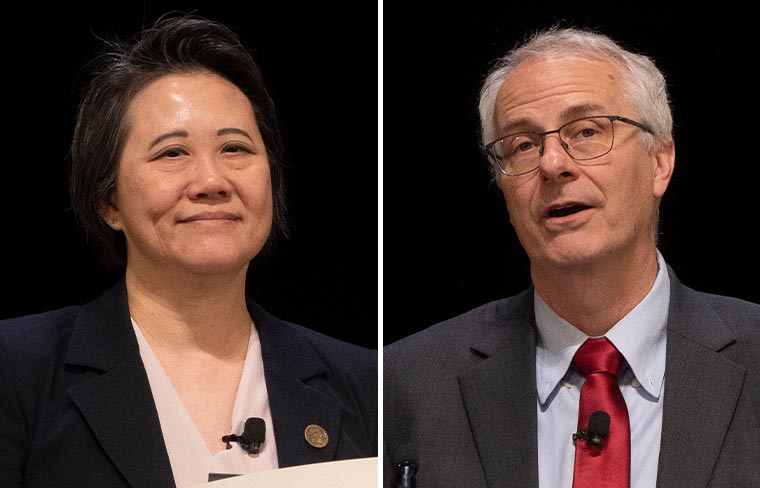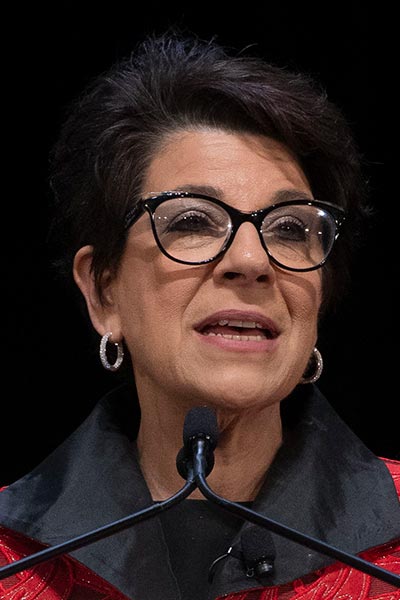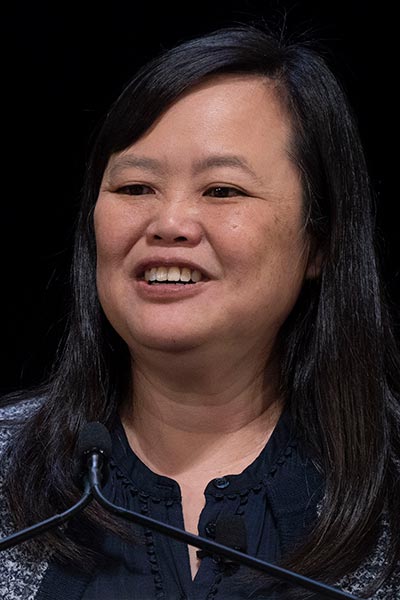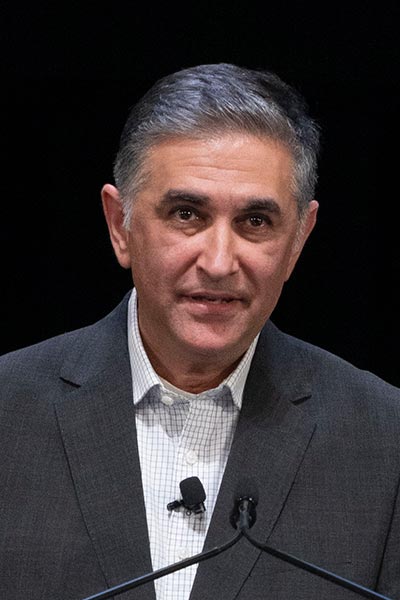Closing Plenary Session showcases meeting’s key takeaways across the continuum of cancer research
The conference wrapped up with the AACR Annual Meeting 2025 Highlights: Vision for the Future Plenary Session, where three speakers took on the herculean task of summarizing the major themes, discoveries, and impact of findings reported throughout the meeting.

“Each speaker has been combing through the program in real time, attending different sessions and selecting the most significant learnings from those sessions,” said AACR President Lillian L. Siu, MD, FAACR, who served as a session moderator and Annual Meeting program chair alongside Matthew G. Vander Heiden, MD, PhD. “It’s a lot of work but a very important task—to capture the essence from all the meeting sessions in that field and concisely summarize the most exciting findings and their impact,” said Siu.
Vander Heiden noted that in addition to summarizing the highlights of the meeting, the session’s speakers would, “perhaps most importantly, discuss where we go from here.”
Key themes from basic and translational research

Cory Abate-Shen, PhD, of Columbia University, identified four major themes from the meeting’s presentations on basic and translational discoveries: chemistry, genomics and epigenomics, tumor cell states and heterogeneity, and the tumor ecosystem.
“I have been attending the AACR [Annual] Meeting for 30 years, and I’ve really seen the evolution in what’s [been] happening over the years,” said Abate-Shen. “The perspective I took was to think about what has been changing in the 30 years since I’ve been attending—and it’s a lot.”
She noted that chemistry advances have fueled a greater understanding of how resistance to RAS inhibition forms and new strategies for overcoming it; led to the development of innovative targeted therapy strategies; and allowed researchers to go after new targets, including the Hippo pathway.
Studying the genome and epigenome throughout the “cancer journey” has provided key insights into how these elements impact cancer development, progression, the tumor microenvironment (TME), and lineage plasticity, Abate-Shen said. It has also allowed researchers to learn how drugs that target epigenetic regulators impact the TME and has uncovered the potential of targeting specific intracellular compartments.
Abate-Shen next explained that advances in spatial and single-cell technologies have revealed the contributions of extrachromosomal DNA, epigenetics, mitochondrial DNA, metabolism, and therapy to tumor heterogeneity and cell states. Future efforts, Abate-Shen said, could target the lineage plasticity that occurs in response to certain therapeutics.
Studies on the tumor ecosystem demonstrated how cancer cell-extrinsic factors such as fibrosis, tissue damage, vasculature, immune cells, and the microbiome impact cancer, and Abate-Shen identified ferroptosis, the nerve-cancer crosstalk, and sex differences in cancer as fields to keep an eye on.
Highlights from social and population sciences

Scarlett Lin Gomez, PhD, MPH, of the University of California, San Francisco, described significant findings in prevention, early detection, population sciences, and disparities research.
The understanding of early-onset cancer continues to grow, and the meeting provided insights into the populations that are most impacted, potential risk factors, and biological mechanisms, such as the influence of the microbiome, Gomez said.
The impact of lifestyle and societal factors on cancer risk was also a major topic, with presentations reporting that GLP-1 may protect against cancer and that chemotherapy is associated with subsequent cancers in pediatric patients.
Gomez shared that another recurring theme was the importance of community-centered interventions to address disparities and improve clinical trial enrollment and access to care, as well as the responsibility of researchers to build trust and combat misinformation. She pointed to the importance of including patient-reported outcomes and quality-of-life measures in clinical trials as a vital step in improving survivorship and patient trust.
Finally, she discussed promising efforts to mitigate disparities in cancer screening and prevention, such as mailing fecal immunochemical tests to improve colorectal cancer screening rates and self-collection of cervical samples to test for HPV. She also highlighted groundbreaking clinical trial results showing that one dose of the HPV vaccine was no less effective than two doses in preventing infection—findings that could dramatically facilitate HPV vaccination across the world. The roles of climate change, policy, social determinants of health, and biology were also key topics throughout the meeting.
In all of these subfields, the meeting’s presentations not only showed the progress that has been made but also demonstrated the need for more research and larger and more inclusive datasets, Gomez said.
She concluded by noting that although efforts to advance public health and cancer prevention strategies are facing many challenges, the meeting’s presentations underscored that researchers have the tools to overcome these setbacks.
“We must persist, and we must have endurance and know that it is a long game—but we are in that game.”
Paradigm-shifting clinical trial results

In the final presentation, Jayesh Desai, MBBS, of Peter MacCallum Cancer Centre, identified the major takeaways from the meeting’s “absolutely outstanding” clinical trials program. Desai was cochair of the Annual Meeting Clinical Trials Committee.
The 38 oral presentations in the clinical trials program included phase I, II, and III trials and showcased how immunotherapy, ctDNA-guided care, targeted therapy, and innovations in CAR T-cell therapy are improving patient outcomes.
Neoadjuvant dostarlimab (Jemperli) led to complete responses in 100% of patients with mismatch repair deficient (dMMR) rectal cancers and 65% of other dMMR cancers, and administering pembrolizumab (Keytruda) both before and after surgery improved outcomes for patients with head and neck cancers.
The neoadjuvant dostarlimab trial also demonstrated that ctDNA may help predict treatment response. Another trial highlighted by Desai suggested that ctDNA could help guide treatment selection by identifying patients whose dMMR tumors are likely to recur after surgery and might, therefore, benefit from adjuvant pembrolizumab.
Several trials highlighted the promise of new targeted therapies, said Desai, with investigational therapeutics against the Werner helicase and ROS1 leading to responses in phase I trials.
Desai also described advances in using CAR T-cell therapy to treat solid tumors, including results from a trial testing ICAM1-targeted CAR T cells for thyroid cancers.
“Cancer drug development is really at an exciting time,” said Desai.
The recording of the full session is available for registered Annual Meeting attendees through October 2025 on the virtual meeting platform.
More from the AACR Annual Meeting 2025
View a photo gallery of scenes from Chicago, continue the conversation on social media using the hashtag #AACR25, and read more coverage in AACR Annual Meeting News.

